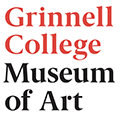-
Artworks

Catherine Opie
American, b. 1961
Bo, 1994
C-print
61 x 31 in. (154.94 x 78.74 cm)
© Catherine Opie. Image courtesy of Regen Projects and Lehmann Maupin, New York, Hong Kong, Seoul, and London.
Grinnell College Museum of Art Collection (2021.001)
Catherine Opie first achieved acclaim for her visionary series of portraits taken in the 1990s of herself and her cohort in the Queer communities of San Francisco and Los Angeles at a dire time in the AIDS pandemic. As friends and acquaintances died and mourned around her in tragic circumstances and numbers, and as those same people were shunned by the public, she captured the marginalized yet proudly defiant in bust and full-length portraits inspired by the great portraits and portraitists of the European Renaissance, notably Hans Holbein portraits of nobility.
But if this is a self-portrait, why is it called Bo? And if portraiture is about identity, what’s with the fake mustache that appears here and throughout the series? Portraiture is not solely about appearance or identity, but one’s power over appearance and identity, and how that power is deployed. The fake mustache is a talisman of identity, performance, gender, gender stereotype, and a selection of one’s existence incognito; an accessory to the bearer’s — and the artist’s — power to beguile.
1of 9


